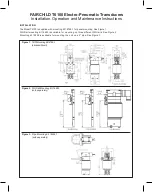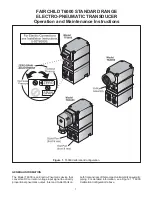
IM 01C25F01-01E
6-3
6. WIRING
(2) Flameproof Type
Wire cables through a flameproof packing adapter, or
use a flameproof metal conduit.
Wiring cable through flameproof packing adapter.
• Apply a non-hardening sealant to the terminal box
connection port and to the threads on the flameproof
packing adapter for waterproofing.
Flameproof packing adapter
Flexible metal conduit
Wiring metal
conduit
Tee
Drain plug
Apply a non-hardening
sealant to the threads for
waterproofing.
F0609.EPS
Figure 6.9 Typical Cable Wiring Using Flameproof Packing
Adapter
Flameproof metal conduit wiring
• A seal fitting must be installed near the terminal box
connection port for a sealed construction.
• Apply a non-hardening sealant to the threads of the
terminal box connection port, flexible metal conduit
and seal fitting for waterproofing.
F0610.EPS
Non-hazardous area
Hazardous area
Flameproof
heavy-gauge
steel conduit
Tee
Drain plug
Seal fitting
Gas sealing device
Flameproof flexible
metal conduit
Apply a non-hardening
sealant to the threads of
these fittings for
waterproofing
After wiring, impregnate the fitting
with a compound to seal tubing.
Figure 6.10
Typical Wiring Using Flameproof Metal
Conduit
6.5 Grounding
Grounding is always required for the proper operation
of transmitters. Follow the domestic electrical require-
ments as regulated in each country. For a transmitter
with a built-in lightning protector, grounding should
satisfy ground resistance of 10
or less.
Ground terminals are located on the inside and outside
of the terminal box. Either of these terminals may be
used.
Ground terminal
(inside)
SUPP
LY
PU
LS
E
CHEC
K
ALAR
M
Ground terminal
(outside)
F0611.EPS
Figure 6.11 Ground Terminals
6.6 Power Supply Voltage and
Load Resistance
When configuring the loop, make sure that the external
load resistance is within the range in the figure below.
(Note) In case of an intrinsically safe transmitter, external load
resistance includes safety barrier resistance.
600
250
0
10.5
16.6
25.2
42
External
load
resistance
R (
Ω
)
Power supply voltage E (V DC)
F0612.EPS
Communication
applicable range
BRAIN and HART
R=
E–10.5
0.0244
Figure 6.12 Relationship between Power Supply Voltage
and External Load Resistance
















































